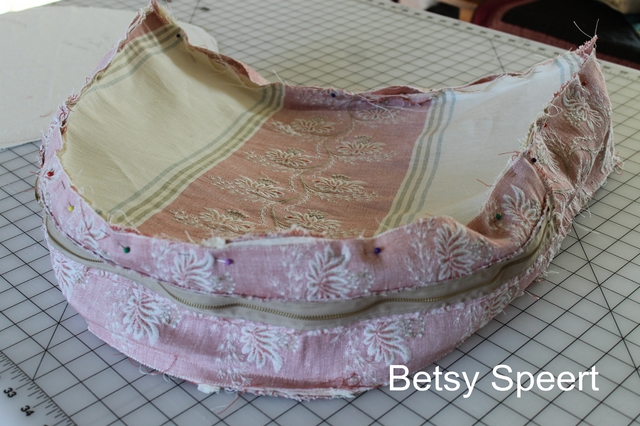Now that I've finished the chair for Kris's guest room, it's time to work on the beds.
This is where we left off.....
I wanted creamy looking sheets and coverlets to go with the tones of the room.
I also wanted cream sheets for Kris's master bedroom.
The creams of the rooms were two slightly different shades, and being the obsessive color freak that I am, I wanted them to actually go with the tones of each room.
Sooooo.....
we went where we figured we would have a lot of choices.
I hate to admit it, but we went to Bloomingdale's.....
My first job out of design school was as the assistant in the Bloomingdale's design department.
I really learned to hate that job.
Being the mature young woman that I was at the time.....
I used to sit at my desk,
staring at the cinderblock wall....
and mutter under my breathe.....
"I hate this job, I hate this job..."
really good for the department morale.
I wasn't a favorite.
OY.
Where was I?????
Oh, yeah, sheets.
SOOOOO.....
Kris and I went to Bloomingdale's.
As soon as we walked into the sheet department, a saleswoman came up to help us.
I told her we wanted cream colored sheets and she took us right away to a section that had them.
I was thinking.....
not a bad shopping experience!!!!!
Maybe my memories of this store are outdated!!!!!
And then I looked at the prices!!!!!
She had taken us to the most expensive sheets in the damn store.
I mean.....we only wanted basic cream!!!!!
If we bought the ones she brought us to, we would have spent over $800.00 for a set of twin size sheets.
ARE YOU KIDDING ME?????
I read a few years ago in Consumer Reports Magazine that anything over 200 thread count was unnecessary.
I don't know if that's true, but I am perfectly happy with a 200 thread count sheet.
Sooooooo.....
we let the sales lady know that we wanted something much more reasonably priced, and she left us to our own devices.
jeesh.....
great service.
We were able to find the sheets we wanted and for the twin beds we found matelasse coverlets and shams from Ralph Lauren.
But we were't able to find duvet covers we liked for the guest room or coverlets and shams for the master bedroom.
We went to Pottery Barn, Bed Bath and Beyond, and looked on the internet.
No luck.
So we then went to Calico Corners for fabric, and I'm making the rest myself.
For the guest room we chose a beautiful green fabric that also has a matelasse look.
Kris was worried it was going to be too much matelasse, but when it's all done, I think it will be fine and dandy.
I also want a patterned pillow to lean against the bed pillows for a little pop of color.
In the picture below I used one Kris had to show what I mean.
I know it doesn't go, but it was good for figuring what we needed.
Here's a closeup of the matelasse coverlet.
I got to hand it to Ralphy baby,
it's a really pretty pattern.
I like to wash new matelasse in hot water and then dry it on regular.
This way it shrinks a little and the quilting details puff up more.
I need to get Kris to wash these new ones, and I'll show you how it really adds more depth of pattern.
The green fabric will be made into duvet covers.
I plan on going to Joanne's and finding some pretty buttons for the closures.
We still have to figure out what we want for the patterned pillows.....
So much decorating.....
So little time.....
When the dust ruffles are made and installed, we will have even more pattern on each bed.
They are going to be the same fabric as the draperies.
Kris just got the new boxspring for the second twin bed.
If you have two different beds and are making a mismatched pair, like we did,
it's important that the two beds end up having mattresses that are the same height off the floor.
The way to do this is to have the boxsprings made with different thicknesses.
This way the top of the boxspring is the same for both beds, so the dust ruffles will look the same.
We had custom mattresses made.
Surprisingly enough, custom mattresses and boxsprings aren't any more expensive than standard sizes.
So now that the boxsprings are here, we can have the dust ruffles made!!!!!
If you want to know what the green fabric is.....
I took a picture of it's tag.
For Kris's Master bedroom we found some more Ralph Lauren fabric that worked with her color scheme.
Here's a shot of her bedroom when we last saw it.....
We (Kris) found a fabric that we liked.
The large stripe fabric actually looked better on the wrong side.
I am making a coverlet out of it, and plan on folding it back so the other side also shows.
Unfortunately, the wrong side has the knotted threads showing, so I don't know if Kris will like that.
She gets back from vacation today, so we'll see.
In my next post I'll show the painful process of making the coverlet so it looks good with finished seams on both sides.
The pillow shams are going to be made out of the smaller stripe.
We still need to find something for the duvet cover.....
OY.
On that note,
Latah, Gatah

.jpg)







.jpg)
.jpg)




















.JPG)



























.JPG)
.JPG)

.JPG)

.JPG)
.JPG)




















.jpg)
.jpg)
.jpg)







